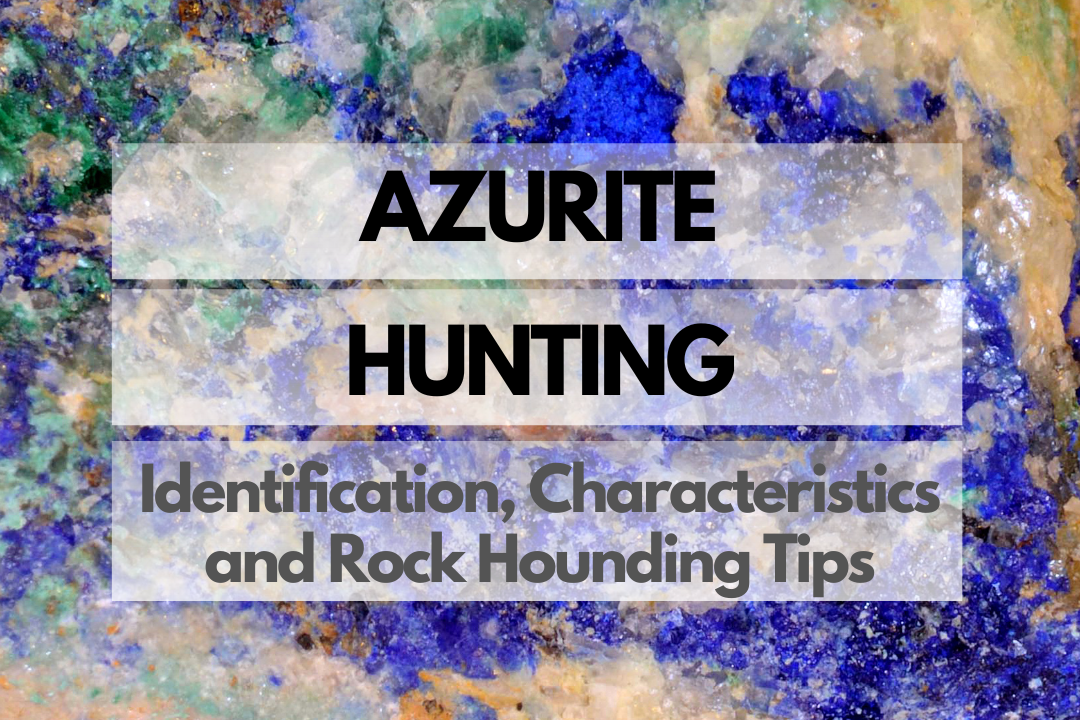There’s something undeniably captivating about azurite, with its vibrant blue hues and unique crystalline structures. In this article, we’ll dive into the fascinating world of azurite hunting, exploring its history, identification, and characteristics. Get ready to embark on an exciting journey as we uncover the secrets of this mesmerizing mineral and learn tips to help you in your rock hounding adventures!
History & Origin of Azurite
Azurite has been known and valued since ancient times, with its earliest recorded use dating back to the ancient Egyptians, who used the mineral as a pigment in their artwork and cosmetics. The name “azurite” comes from the Persian word “lazhward,” which means “blue” a fitting name for this vividly colored mineral. Azurite has also been assigned various cultural significances, including being considered a symbol of wisdom, spiritual growth, and psychic abilities.
Azurite Identification & Physical Properties
| Property | Description |
|---|---|
| Color | Shades of blue |
| Hardness | 3.5 – 4 on the Mohs scale |
| Luster | Vitreous to dull |
| Streak | Blue |
| Transparency | Transparent to translucent |
| Crystal System | Monoclinic |
Azurite Colors
Azurite is well-known for its striking, deep blue color, which ranges from azure to dark indigo. The intensity of the color can vary depending on factors such as the size and purity of the crystals, with larger and more pure specimens boasting the most vibrant hues.
Azurite Hardness
Azurite has a hardness of 3.5 to 4 on the Mohs scale, making it a relatively soft mineral. This characteristic can make it more challenging to work with for some purposes, but it also means that it can be easily carved and shaped into intricate designs.
Azurite Types
Rosette Azurite
Rosette azurite is characterized by its unique growth pattern, which resembles that of a flower with radiating, petal-like crystals. This type of azurite is typically found in association with other secondary copper minerals, such as malachite.
Crystalline Azurite
Crystalline azurite is characterized by well-formed, individual crystals that can range in size from microscopic to several centimeters in length. These crystals often exhibit a deep blue color and can be found in various forms, such as prismatic, tabular, or bladed.
Massive Azurite
Massive azurite is characterized by its lack of visible crystal faces and typically forms as a result of the replacement of other copper-bearing minerals. This type of azurite can vary greatly in color and appearance, from solid blue masses to those intermixed with other minerals like malachite or chrysocolla.
Azurite Uses
- Pigment for paints and dyes
- Ornamental stone for carvings and sculptures
- Jewelry and decorative items
- Mineral specimens for collectors
- Metaphysical and healing purposes
How Much Is Azurite Worth?
The value of azurite can vary greatly depending on factors such as size, color, crystal quality, and overall aesthetic appeal. Small, low-quality specimens can be found for just a few dollars, while larger, high-quality pieces can fetch hundreds or even thousands of dollars. As always, the value of a specific specimen is ultimately determined by what a buyer is willing to pay for it.
Azurite Rock Hounding Tips
Ready to embark on an azurite hunting adventure? Here are some tips and tricks to help you have a successful and enjoyable experience as you search for this stunning blue mineral.
Essential Tools and Equipment
Having the right tools and equipment can make all the difference in your rock hounding endeavors. Here are some essentials to consider bringing along:
- Rock hammer or geologist’s pick
- Chisels and pry bars for breaking rock
- Hand lens or magnifying glass for examining specimens
- Hard hat and safety goggles for protection
- Sturdy gloves to protect your hands
- Backpack or collecting bag for carrying your finds
- Field guide or mineral identification book
- First aid kit and emergency supplies
Safety Tips
Rock hounding can be a fun and rewarding pastime, but it’s important to prioritize safety. Here are some tips to keep in mind:
- Always wear appropriate safety gear, including a hard hat, gloves, and goggles.
- Never go rock hounding alone. Bring a buddy or join a group for added safety.
- Be aware of your surroundings and avoid unstable cliffs, overhangs, or loose rock.
- Stay hydrated and bring plenty of water, especially when hunting in hot or arid environments.
- Follow all posted signs, rules, and regulations for the area in which you are rock hounding.
Azurite Hunting: Where to Find Azurite
Azurite can be found in various locations around the world, often in association with other copper-bearing minerals. Some of the best places to find azurite include copper mining regions and areas with significant geological activity. Below is a table detailing specific sites and countries where azurite can be found.
| Site/Area | City/State/Country |
|---|---|
| Bisbee | Arizona, USA |
| Tsumeb Mine | Tsumeb, Namibia |
| Chessy-les-Mines | Rhône, France |
| La Salada | Zacatecas, Mexico |
| Burra Burra Mine | South Australia, Australia |
Caring For Your Azurite
To keep your azurite specimens looking their best, follow these care tips:
- Avoid exposing azurite to direct sunlight, as its color can fade over time.
- When cleaning azurite, use a soft cloth or brush and avoid using harsh chemicals or abrasives.
- Store azurite specimens in a cool, dry place, away from moisture and extreme temperature fluctuations.
Additional Resources
If you’re looking to deepen your knowledge of azurite and rock hounding, consider exploring these resources:
- Mindat.org – A comprehensive database of minerals, including azurite
- United States Geological Survey (USGS) – Offers a wealth of information on geology, mineral resources, and more
- Rockhounds.com – A community forum for rock hounding enthusiasts
- Books: “Rocks, Gems, and Minerals” by Herbert S. Zim and Paul R. Shaffer, and “Rockhounding Series” by various authors
Additional Azurite FAQs
What are the benefits of Azurite?
Beyond its beauty and use as a collector’s item, azurite has beenused historically as a pigment in paint, as a copper ore, and in jewelry. Its vibrant blue color makes it an attractive option for artistic and decorative purposes.
Do Azurite have any healing properties?
While some people believe that azurite possesses healing properties, such as aiding in communication and mental clarity, there is no scientific evidence to support these claims. It’s important to note that the use of azurite or any other mineral for healing purposes should not replace medical advice or treatment.
Do Azurite have any spiritual meaning?
In some spiritual and metaphysical circles, azurite is associated with the third eye chakra and is believed to help with intuition, spiritual insight, and psychic abilities. However, these beliefs are subjective and not based on scientific evidence.
Do I need a permit to go Azurite hunting?
In some cases, a permit may be required to go rock hounding or mineral collecting, especially on public lands or in designated collecting areas. It’s important to research the regulations and requirements for the specific area where you plan to hunt for azurite. For more information on permits and regulations in the United States, visit the Bureau of Land Management (BLM) rockhounding page.
Closing Thoughts
Azurite hunting can be a thrilling and rewarding adventure, offering the chance to connect with nature, explore new places, and add a stunning specimen to your collection. With the right tools, safety precautions, and knowledge of where to find azurite, you’ll be well on your way to a successful rock hounding experience. So grab your gear, gather your fellow rock hounding enthusiasts, and embark on a journey to uncover the beauty of azurite!

